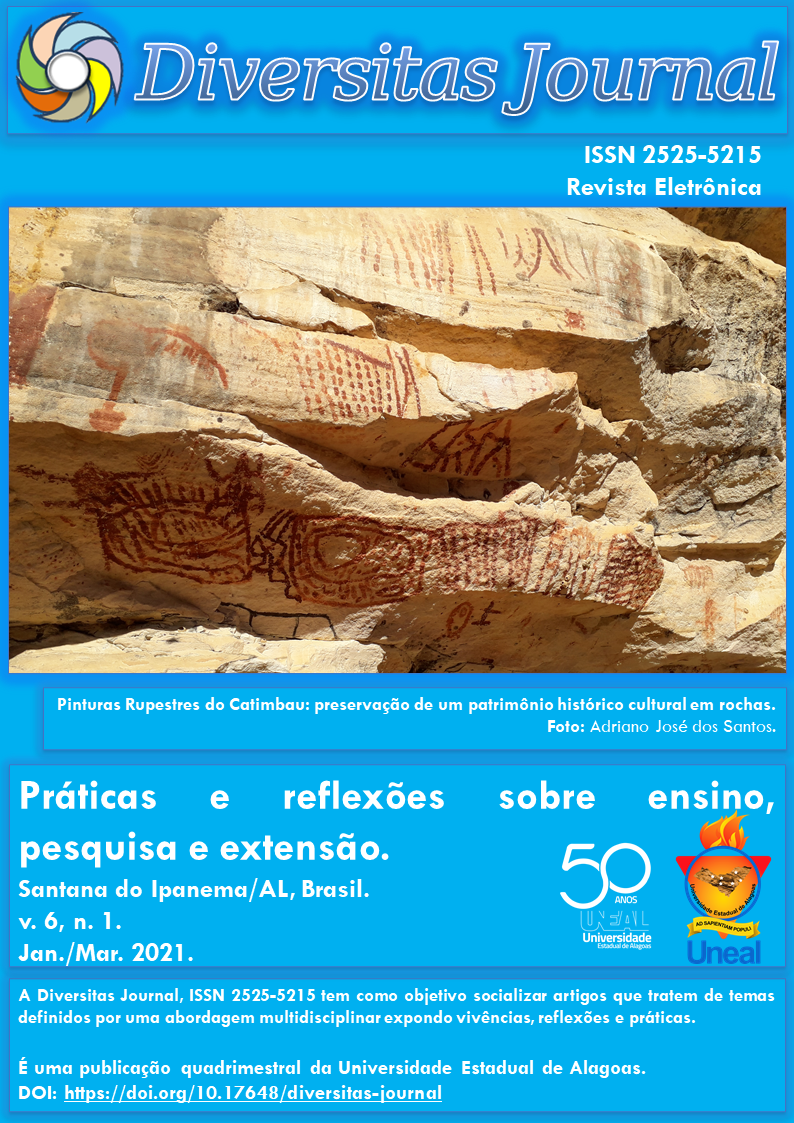Recobrimento de Superfícies metálicas por Filmes de Titânia meso-macroporosa
DOI:
https://doi.org/10.17648/diversitas-journal-v6i1-1467Abstract
Improvement of porous materials has been one of the goals of nanotechnology. There is an increasingly real need to understand the mechanisms that generate self-structured materials specifically those that originate from colloidal particle templates such as: polymers, silica, titania and silicon. These templates are important to produce devices with industrial applications such as: solar cells, desalinizers, batteries and photonic crystals. One of the main difficulties encountered in the application of colloidal particles is to produce them on a large scale with uniform size and deposit them on flat surfaces so that they can homogeneously cover a substrate forming crystallographic domains on a micrometric scale. The objective of this work is to analyze the formation of nanocrystalline films of titania on metallic surfaces that were characterized by scanning electron microscopy (SEM). The metallic substrates were commercial steel plates found in hardware stores. The substrate was covered with latex beads infiltrated by a precursor solution of titania and subsequently heat treated in a tubular oven at 600 oC for one hour. It is observed that the metallic substrate influences the topography of the mesoporous titania film resulting in a lamellar structure in which interaction with the external environment is suitable. These results show that the nature of the substrate directly influences the topography of the mesoporous titania, which is no longer hexagonal with ordered pores but lamellar allowing the production of self-cleaning membranes with direct application in civil construction.
Metrics
References
CARBAJO, María C. et al. Micro/nano-structural properties of imprinted macroporous titania and zirconia. Journal of Materials Chemistry, v. 13, n. 9, p. 2311-2316, 2003.
CARBAJO, María C.; ENCISO, E.; TORRALVO, María J. Synthesis and characterization of macro-mesoporous titania. Colloids and Surfaces A: Physicochemical and Engineering Aspects, v. 293, n. 1-3, p. 72-79, 2007.
CHO, Young-Sang et al. Spherical meso-macroporous silica particles by emulsion-assisted dual-templating. Materials Express, v. 4, n. 2, p. 91-104, 2014.
CHOI, Sung Yeun et al. Thermally stable two‐dimensional hexagonal mesoporous nanocrystalline anatase, meso‐nc‐TiO2: Bulk and crack‐free thin film morphologies. Advanced Functional Materials, v. 14, n. 4, p. 335-344, 2004.
CREPALDI, Eduardo L. et al. Controlled formation of highly organized mesoporous titania thin films: from mesostructured hybrids to mesoporous nanoanatase TiO2. Journal of the American Chemical Society, v. 125, n. 32, p. 9770-9786, 2003.
FELTRIN, J. et al. Superfícies fotocatalíticas de titânia em substratos cerâmicos: Parte I: Síntese, estrutura e fotoatividade. Cerâmica, v. 59, n. 352, p. 620-632, 2013.
GU, Dong; SCHÜTH, Ferdi. Synthesis of non-siliceous mesoporous oxides. Chemical Society Reviews, v. 43, n. 1, p. 313-344, 2014.
HOLLAND, Brian T.; BLANFORD, Christopher F.; STEIN, Andreas. Synthesis of Macroporous Minerals with Highly Ordered Three-Dimensional Arrays of Spheroidal Voids. Science, v.281, n.5376, p.538-540, 1998.
HOLLAND, Brian T. et al. Synthesis of highly ordered, three-dimensional, macroporous structures of amorphous or crystalline inorganic oxides, phosphates, andhybrid composites. Chemistry of Materials, v. 11, n. 3, p. 795-805, 1999.
LI, Hongyu et al. Ordered macroporous titania photonic balls by micrometer-scale spherical assembly templating. Journal of Materials Chemistry, v. 15, n. 26, p. 2551-2556, 2005.
MEDEIROS, Marcelo Henrique Farias de et al. Compósitos de cimento Portland com adição de nanotubos de carbono (NTC): Propriedades no estado fresco e resistência à compressão. Matéria (Rio de Janeiro), v. 20, n. 1, p. 127-144, 2015.
MESEGUER, F.Colloidal crystals as photonic crystals. Colloids and Surfaces A: Physicochemical and Engineering Aspects, v. 270, p. 1-7, 2005.
NUNES, Everton Barbosa et al. Influência da energia de soldagem na microestrutura e na microdureza de revestimentos de aço inoxidável duplex. Soldagem & Inspeção, v. 17, n. 2, p. 114-122, 2012.
RELATÓRIO 274/2007 –NMM: Aplicação de titânio e suas ligas na construção: Estudo da Corrosão Galvânica do Par Aço Inoxidável/Titânio em Meio Alcalino. Lisboa: Laboratório Nacional de Engenharia Civil, 2007. Disponível em http://repositorio.lnec.pt:8080/jspui/bitstream/123456789/16129/1/Rel274_07.pdf. Acesso: 16 ago. 2020.
SILVA, Antony Ernesto dos Santos et al. Analysis of Styrene Polymerization Without Surfactant and N2Gas in Cylindrical Flask. Materials Research, v. 20, p. 800-807, 2017.
SYOUFIAN, Akhmad; NAKASHIMA, Kenichi. Degradation of methylene blue in aqueous dispersion of hollow titania photocatalyst: study of reaction enhancement by various electron scavengers. Journal of colloid and interface science, v. 317, n. 2, p. 507-512, 2008.
TECNOSIL, sílica ativa. Nanotecnologia na construção civil: quais as principais aplicações (e consequências)? Itupeva/São Paulo: Itupeva, 2018. Disponível em: http://www.tecnosilbr.com.br/conteudo/?p=244. Acesso: 10 Jul. de 2020.
YOKOI, Toshiyuki; YOSHITAKE, Hideaki; TATSUMI, Takashi. Synthesis of mesoporous silica by using anionic surfactant. Studies in Surface Science and Catalysis, v. 154, Parte A, p. 519-527, 2004.
Downloads
Published
How to Cite
Issue
Section
License
Copyright (c) 2021 Giselly Correia Cavalcante, Djalma de Albuquerque Barros Filho, Alan John Duarte de Freitas, Jonas dos Santos Sousa, Johnnatan Duarte de Freitas, Weverton Martiniano Moreira

This work is licensed under a Creative Commons Attribution 4.0 International License.
The Diversitas Journal expresses that the articles are the sole responsibility of the Authors, who are familiar with Brazilian and international legislation.
Articles are peer-reviewed and care should be taken to warn of the possible incidence of plagiarism. However, plagiarism is an indisputable action by the authors.
The violation of copyright is a crime, provided for in article 184 of the Brazilian Penal Code: “Art. 184 Violating copyright and related rights: Penalty - detention, from 3 (three) months to 1 (one) year, or fine. § 1 If the violation consists of total or partial reproduction, for the purpose of direct or indirect profit, by any means or process, of intellectual work, interpretation, performance or phonogram, without the express authorization of the author, the performer, the producer , as the case may be, or whoever represents them: Penalty - imprisonment, from 2 (two) to 4 (four) years, and a fine. ”















.png)




